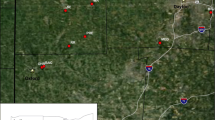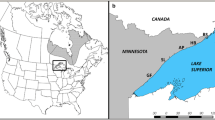Abstract
In facultatively asexual invasive species, an understanding of the origins and diversity of clones can reveal introduction and invasion pathways and inform management efforts. In this study, we use microsatellite and chloroplast DNA markers to infer clonal diversity of the Rubus fruticosus agg. invasion in the Western United States, determine the relationship of these clones to clones found in other exotic ranges, and determine the geographic and genetic origins of the invasive clones. We found two invasive clones in the Western United States, where the invasion had previously been thought to consist of a single asexual lineage. The most common clone was genetically identical to the microspecies R. armeniacus from the native range of Germany, while the second clone was identical to the microspecies R. anglocandicans in the invaded range of Australia and closely related to samples from the native ranges of England and Serbia. A third distinct clone was identified in a collection from the exotic range of Chile. Our results demonstrate that cryptic genetic diversity may be present in asexual invasions that are thought to be homogeneous. However, the asexual relationships between R. fruticosus agg. clones in the native and multiple exotic ranges indicate that preadaptation has played an important role in invasion success in this species aggregate.





Similar content being viewed by others
References
Amsellem L, Noyer JL, Le Bourgeois T, Hossaert-McKey M (2000) Comparison of genetic diversity of the invasive weed Rubus alceifolius Poir. (Rosaceae) in its native range and in areas of introduction, using amplified fragment length polymorphism (AFLP) markers. Mol Ecol 9:443–455
Amsellem L, Noyer JL, Hossaert-McKey M (2001) Evidence for a switch in the reproductive biology of Rubus alceifolius (Rosaceae) towards apomixis, between its native range and its area of introduction. Am J Bot 88:2243–2251
Arnaud-Haond S, Duarte CM, Alberto F, Serrão A (2007) Standardizing methods to address clonality in population studies. Mol Ecol 16:5115–5139
Bailey LH (1923) Certain cultivated Rubi. Gentes Herb 1:196–200
Bailey LH (1945) Species Batorum. The genus Rubus in North America. IX. Arguti. European species introduced. Gentes Herb 5:590–856
Bammi RK, Olmo HP (1966) Cytogenetics of Rubus V: natural hybridization between R. procerus P J Muell and R. laciniatus Wild. Evolution 20:617–633
Birky CW (1983) Relaxed cellular controls and organelle heredity. Science 222:468–475
Bossdorf O, Auge H, Lafuma L, Rogers WE, Siemann E, Prati D (2005) Phenotypic and genetic differentiation between native and introduced plant populations. Oecologia 144:1–11
Bousquet J, Simon L, Lalonde M (1990) DNA amplification from vegetative and sexual tissues of trees using polymerase chain reaction. Can J For Res 20:254–257
Bruvo R, Michiels NK, D’Souza TG, Schulenburg H (2004) A simple method for the calculation of microsatellite genotype distances irrespective of ploidy level. Mol Ecol 13:2101–2106
Bruzzese E (1998) The biology of blackberry in south-eastern Australia. Plant Prot Q 13:160–162
Caplan JS, Yeakley JA (2010) Water relations advantages for invasive Rubus armeniacus over two native ruderal congeners. Plant Ecol 210:169–179
Ceska A (1999) Rubus armeniacus: a correct name for Himalayan blackberries. Bot Electron News 230
Clark LV, Jasieniuk M (2011) POLYSAT: an R package for polyploid microsatellite analysis. Mol Ecol Resour 11:562–566
Darrow GM (1931) European blackberry seedlings and hybrids—in the Pacific Northwest. J Hered 22:143–146
De Silva HN, Hall AJ, Rikkerink E, McNeilage MA, Fraser LG (2005) Estimation of allele frequencies in polyploids under certain patterns of inheritances. Heredity 95:327–334
DiTomaso JM, Healy EA (2007) Weeds of California and Other Western States. University of California Division of Agriculture and Natural Resources, Oakland
Dlugosch KM, Parker IM (2008) Founding events in species invasions: genetic variation, adaptive evolution, and the role of multiple introductions. Mol Ecol 17:431–449
Dybdahl MF, Drown DM (2011) The absence of genotypic diversity in a successful parthenogenetic invader. Biol Invasions 13:1663–1672
Edees ES, Newton A (1988) Brambles of the British Isles. The Ray Society, London
Ellstrand NC, Schierenbeck KA (2000) Hybridization as a stimulus for the evolution of invasiveness in plants. Proc Nat Acad Sci USA 97:7043–7050
Ertter B (1993) Rubus. In: Hickman JC (ed) The Jepson Manual: higher plants of California. University of California Press, Berkeley, pp 974–975
Estoup A, Guillemaud T (2010) Reconstructing routes of invasion using genetic data: why, how and so what? Mol Ecol 19:4113–4130
Evans KJ, Weber HE (2003) Rubus anglocandicans (Rosaceae) is the most widespread taxon of European blackberry in Australia. Aust Syst Bot 16:527–537
Evans KJ, Jones MK, Roush RT (2005) Susceptibility of invasive taxa of European blackberry to rust disease caused by the uredinial stage of Phragmidium violacium under field conditions in Australia. Plant Pathol 54:275–286
Evans KJ, Symon DE, Whalen MA, Hosking JR, Barker RM, Oliver JA (2007) Systematics of the Rubus fruticosus aggregate (Rosaceae) and other exotic Rubus taxa in Australia. Aust Syst Bot 20:187–251
Facon B, Genton BJ, Shykoff J, Jarne P, Estoup A, David P (2006) A general eco-evolutionary framework for understanding bioinvasions. Trends Ecol Evol 21:130–135
Graham J, Smith K, Woodhead M, Russell J (2002) Development and use of simple sequence repeat SSR markers in Rubus species. Mol Ecol Notes 2:250–252
Gaskin JF, Zhang DY, Bon MC (2005) Invasion of Lepidium draba (Brassicaceae) in the western United States: distributions and origins of chloroplast DNA haplotypes. Mol Ecol 14:2331–2341
Hall HK (1990) Blackberry Breeding. In: Janick J (ed) Plant Breeding Reviews. Timber Press, Inc., Portland, pp 249–312
Hall HK, Cohen D, Skirvin RM (1986) The inheritance of thornlessness from tissue culture-derived thornless evergreen blackberry. Euphytica 35:891–898
Hitchcock CL, Cronquist A, Ownby M, Thompson JW (1961) Vascular Plants of the Pacific Northwest. University of Washington Press, Seattle
Hoshovsky MC (2000) Rubus discolor Weihe & Nees. In: Bossard CC, Randall JM, Hoshovsky MC (eds) Invasive Plants of California’s Wildlands. University of California Press, Berkeley, pp 277–281
Howarth DG, Gardner DE, Morden CW (1997) Phylogeny of Rubus subgenus Idaeobatus (Rosaceae) and its implications toward colonization of the Hawaiian Islands. Syst Bot 22:433–441
Jauhar PP, Joshi AB (1970) The concept of species and “microspecies”. Taxon 19:77–79
Kollmann J, Steinger T, Roy BA (2000) Evidence of sexuality in European Rubus (Rosaceae) species based on AFLP and allozyme analysis. Am J Bot 87:1592–1598
Kraft T, Nybom H (1995) DNA fingerprinting and biometry can solve some taxonomic problems in apomictic blackberries (Rubus subgen. Rubus). Watsonia 20:329–343
Lee CE (2002) Evolutionary genetics of invasive species. Trends Ecol Evol 17:386–391
Lockwood JL, Cassey P, Blackburn T (2005) The role of propagule pressure in explaining species invasions. Trends Ecol Evol 20:223–228
Lopes MS, Maciel G, Mendonça D, Sabino Gil F, Da Câmara Machado A (2006) Isolation and characterization of simple sequence repeat loci in Rubus hochstetterorum and their use in other species from the Rosaceae family. Mol Ecol Notes 6:750–752
Meirmans PG, Van Tienderen PH (2004) GENOTYPE and GENODIVE: two programs for the analysis of genetic diversity of asexual organisms. Mol Ecol Notes 4:792–794
Mes THM (1998) Character compatibility of molecular markers to distinguish asexual and sexual reproduction. Mol Ecol 7:1719–1727
Novak SJ, Mack RN (2005) Genetic bottlenecks in alien plant species: Influence of mating systems and introduction dynamics. In: Sax DF, Stachowicz JJ, Gaines SD (eds) Species invasions: insights into ecology, evolution, and biogeography. Sinauer Associates, Sunderland, pp 201–228
Nybom H (1988) Apomixis versus sexuality in blackberries (Rubus subgen. Rubus, Rosaceae). Plant Syst Evol 160:207–218
Okada M, Lyle M, Jasieniuk M (2009) Inferring the introduction history of the invasive apomictic grass Cortaderia jubata using microsatellite markers. Divers Distrib 15:148–157
Paradis E, Claude J, Strimmer K (2004) APE: analyses of phylogenetics and evolution in R language. Bioinformatics 20:289–290
Pennycook SR (1998) Blackberry in New Zealand. Plant Prot Q 13:163–174
R Development Core Team (2011) R: a language and environment for statistical computing, 2.11 edn. R Foundation for Statistical Computing, Vienna, Austria
Roderick G, Navajas, M (2003) Genes in new environments: Genetics and evolution in biological control. Nat Rev Genet 4:889–899
Schierenbeck KA, Ellstrand NC (2009) Hybridization and the evolution of invasiveness in plants and other organisms. Biol Invasions 11:1093–1105
United States National Park Service and University of Georgia—Center for Invasive Species and Ecosystem Health (2009) Invasive plant atlas of the United States
USDA-ARS National Genetic Resources Program (2011) Germplasm Resources Information Network (GRIN). National Germplasm Resources Laboratory, Beltsville
Van Oosterhout C, Hutchinson WF, Wills DPM, Shipley P (2004) MICRO-CHECKER: software for identifying and correcting genotyping errors in microsatellite data. Mol Ecol Notes 4:535–538
Wares JP, Hughes AR, Grosberg RK (2005) Mechanisms that drive evolutionary change: insight from species introductions and invasions. In: Species invasions: insights into ecology, evolution, and biogeography. Sinauer Associates, Sunderland, pp 229–258
Weber HE (1995) Rubus. In: Heji G (ed) Illustrierte Flora von Mitteleuropa, 3rd edn. Blackwell Wissenschafts-Verlag, Berlin, pp 284–595
Weber HE (1996) Former and modern taxonomic treatment of the apomictic Rubus complex. Folia Geobot Phytotaxon 31:373–380
Wilkinson M (2001) PICA 4.0: software and documentation. Department of Zoology, The Natural History Museum, London
Zhang YY, Zhang DY, Barrett SCH (2010) Genetic uniformity characterizes the invasive spread of water hyacinth (Eichhornia crassipes), a clonal aquatic plant. Mol Ecol 19:1774–1786
Acknowledgments
Bernie May, Paul Gepts, Kristina Schierenbeck, Associate Editor Richard Lankau and two anonymous reviewers provided insightful comments on earlier versions of this manuscript. Susan Lambrecht, Ramona Robison, Kristina Schierenbeck, Jeff Firestone, Anna Sherwood, Annabelle Kleist, Noor-ul-ain Noor, Cosumnes River Preserve, Caswell Memorial State Park, and Pacific Star Gardens gave assistance and permissions for field collections. Stella Hartono and Isaac Nelson-King assisted with genotyping. The United States Department of Agriculture—National Clonal Germplasm Repository at Corvallis, Oregon kindly provided leaf and seed material for the worldwide Rubus fruticosus agg. dataset. The first author (LVC) was supported on a University of California-Davis Plant Sciences Departmental Graduate Research Assistantship. Research was funded by a Jastro-Shields Research Award and a California Weed Science Society scholarship.
Author information
Authors and Affiliations
Corresponding author
Electronic supplementary material
Below is the link to the electronic supplementary material.
10530_2012_369_MOESM1_ESM.pdf
Online Resource 1 Supplementary tables and figures. Detailed information is provided regarding sampling sites, accessions, ploidy, chloroplast data, and genetic clustering. Supplementary material 1 (PDF 583 kb)
Rights and permissions
About this article
Cite this article
Clark, L.V., Evans, K.J. & Jasieniuk, M. Origins and distribution of invasive Rubus fruticosus L. agg. (Rosaceae) clones in the Western United States. Biol Invasions 15, 1331–1342 (2013). https://doi.org/10.1007/s10530-012-0369-8
Received:
Accepted:
Published:
Issue Date:
DOI: https://doi.org/10.1007/s10530-012-0369-8




